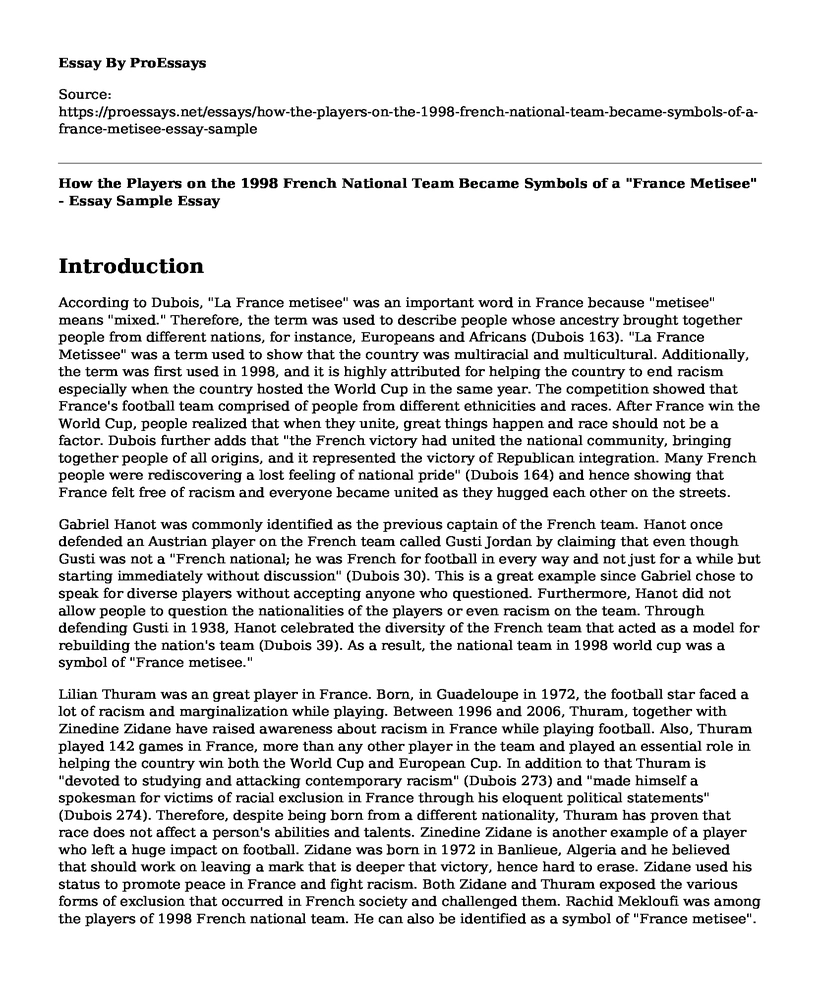Introduction
According to Dubois, "La France metisee" was an important word in France because "metisee" means "mixed." Therefore, the term was used to describe people whose ancestry brought together people from different nations, for instance, Europeans and Africans (Dubois 163). "La France Metissee" was a term used to show that the country was multiracial and multicultural. Additionally, the term was first used in 1998, and it is highly attributed for helping the country to end racism especially when the country hosted the World Cup in the same year. The competition showed that France's football team comprised of people from different ethnicities and races. After France win the World Cup, people realized that when they unite, great things happen and race should not be a factor. Dubois further adds that "the French victory had united the national community, bringing together people of all origins, and it represented the victory of Republican integration. Many French people were rediscovering a lost feeling of national pride" (Dubois 164) and hence showing that France felt free of racism and everyone became united as they hugged each other on the streets.
Gabriel Hanot was commonly identified as the previous captain of the French team. Hanot once defended an Austrian player on the French team called Gusti Jordan by claiming that even though Gusti was not a "French national; he was French for football in every way and not just for a while but starting immediately without discussion" (Dubois 30). This is a great example since Gabriel chose to speak for diverse players without accepting anyone who questioned. Furthermore, Hanot did not allow people to question the nationalities of the players or even racism on the team. Through defending Gusti in 1938, Hanot celebrated the diversity of the French team that acted as a model for rebuilding the nation's team (Dubois 39). As a result, the national team in 1998 world cup was a symbol of "France metisee."
Lilian Thuram was an great player in France. Born, in Guadeloupe in 1972, the football star faced a lot of racism and marginalization while playing. Between 1996 and 2006, Thuram, together with Zinedine Zidane have raised awareness about racism in France while playing football. Also, Thuram played 142 games in France, more than any other player in the team and played an essential role in helping the country win both the World Cup and European Cup. In addition to that Thuram is "devoted to studying and attacking contemporary racism" (Dubois 273) and "made himself a spokesman for victims of racial exclusion in France through his eloquent political statements" (Dubois 274). Therefore, despite being born from a different nationality, Thuram has proven that race does not affect a person's abilities and talents. Zinedine Zidane is another example of a player who left a huge impact on football. Zidane was born in 1972 in Banlieue, Algeria and he believed that should work on leaving a mark that is deeper that victory, hence hard to erase. Zidane used his status to promote peace in France and fight racism. Both Zidane and Thuram exposed the various forms of exclusion that occurred in French society and challenged them. Rachid Mekloufi was among the players of 1998 French national team. He can also be identified as a symbol of "France metisee". The player, however, was born in Algeria. Mekloufi was a football star as he had played professionally and was called to serve the revolution in Algeria. He played for Saint-Etienne and was meant to play in the 1998 world cup but he chose to join the F.L.N movements which is an anti-French revolutionary movement. As a result, he left France when he had been given the opportunity to play the 1998 world cup. He was accepted back into Saint-Etienne and was kept on the team despite the death threats he received. He led the team to victory and used football as a way of spreading peace and finally ending the Algerian war (Dubois 267). Marius Tresor was a footballer that was born in Guadalupe at a place called Sainte-Anne. In his youth, he represented the Antilles in France and was later identified as a "black French". He was the first black person to be elected as the team captain (Dubois 48). Tressor was also identified as the first Antillean players that left a mark on the French international football (Dubois 49).
Conclusion
In conclusion, "France metisee" was symbolized by the players of the French national team in 1998. The combination of different races on the team combined with the unity of the players and the fans is a clear indication that France was a "France metisee." The unity and togetherness of the players made a great contribution to the victory of France in the 1998 World Cup. Furthermore, the lack of discrimination towards and among the players also contributed to France becoming a "France metisee." Therefore, the French national team in 1998 proved that football could indeed be used to portray France as a "France metisee."
Work Cited
Dubois, Laurent. Soccer Empire: The World Cup and the Future of France. Univ. of California Press, 2011.
Cite this page
How the Players on the 1998 French National Team Became Symbols of a "France Metisee" - Essay Sample. (2022, Dec 17). Retrieved from https://proessays.net/essays/how-the-players-on-the-1998-french-national-team-became-symbols-of-a-france-metisee-essay-sample
If you are the original author of this essay and no longer wish to have it published on the ProEssays website, please click below to request its removal:
- Essay Example on Fitness Industry Analysis
- Article Review 'Athletes and Herbal Supplements'
- Emotions Influence on Athletes and Teams Paper Example
- Football, Rape Culture, and the Neoliberal University (as) Brand
- Essay Sample on Division I Student-Athletes
- The Relationship Between Physical Fitness and Lifeguarding - Essay Sample
- Essay Sample on Student-Athletes: The Powerhouses of the Sports Industry







